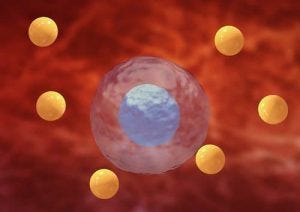Everything You Need to Know About Antioxidants and Free Radicals
Medically Reviewed by Dr. Parris Kidd
Ever hear the term “free radical?”
Nope, I’m not referring to a protester from the 60s.
In medical terms, free radicals refer to something completely different.
What Are Free Radicals?

Free radicals are atoms or molecules with unpaired electrons. Electrons have an irresistible drive to occur in pairs, so unpaired electrons seek to grab electrons from any source available. This is what makes a free radical atom or molecule so chemically reactive.
Electrons are the building blocks of atoms, and atoms are the basic elements of molecules, which are the basis of life as we know it. By robbing electrons from biological molecules, free radicals damage and threaten the ongoing existence of living things – including humans.
Free radicals can come from outside the body, but are also generated by our bodies. Our cells use oxygen to make energy. In the process, some of the oxygen is unavoidably converted into free radicals (“oxyradicals”).
These must be tightly controlled, or they can destroy DNA, proteins, and other key cell components. All our cells have antioxidant enzymes for this purpose.
Our cells’ antioxidant nutrients and enzymes function to neutralize oxyradicals and other free radicals generated from them. But as the body ages, its ability to manage free radicals declines. This reduction of antioxidant power has been linked to the weakening of brain, heart, immune, and practically all other organ functions.
Some experts have developed hypotheses that link the increasing dominance of free radical activity in the body with the aging itself. A huge body of clinical and other research implicates poor antioxidant defense with progressing loss of bodily functions over time.
Numerous lifestyle and environmental factors can increase the body’s free radical burden, whether by making more oxyradicals or creating other molecules with free radical activity. These include, but aren’t limited to:
- Smoking – any hot gas entering the lungs threatens to overwhelm their antioxidant defenses.
- Standard American diet – high heat during cooking, as well as insufficient supplies of nutrients that are essential cofactors for antioxidant enzymes, especially vitamins A, C, E, and K and the minerals zinc, selenium, manganese, and iron.
- Toxic exposure – to chemicals, pollution, pesticides, etc.
- Radiation exposure – chemotherapy, excessive sunlight, and numerous pharmaceuticals have free radical activity.
Antioxidants and Free Radicals
Many have questions about the relationship between antioxidants and free radicals. For optimal physical and physiological function over the long haul, it’s crucial that the body has sufficient antioxidant defense against free radical activity. When the body’s antioxidant defenses lose ground, a situation termed oxidative stress develops.
Antioxidants are molecules able to donate electrons to free radicals and thereby neutralize them. We get nutrient antioxidants from our foods – not just vitamins and minerals, but also from thousands of different types of flavonoids and other polyphenols. Foods such as berries, citrus fruits, other fruits, and vegetables provide substantial supplies of these healthy substances.
Our antioxidant enzyme system is vital to our health. This includes numerous different enzymes, but in order to neutralize oxyradicals and other free radicals, the various enzymes must have iron, zinc, copper, selenium, or manganese built into their protein structure. These must come from our diet.
Importance of Immunity
Having a healthy immune system is crucial to survival and is key in the struggle between antioxidants and free radicals. Immunity is your body’s main natural protection system, and it carries out two primary functions – defense and tolerance.
It defends against bacteria, viruses, parasites, and other potential troublemakers. Our immune cells sometimes produce free radicals to destroy such infectious agents.
Many of our immune cells generate highly toxic free radicals from oxygen, chlorine, or even bromine. As they get into close combat with their intended targets, their free radical weaponry can threaten their own survival. Healthy immune cells tend to have high levels of antioxidant nutrients and enzymes as protection against accidental self-destruction.
Your immune system also regulates your level of tolerance to potential environmental triggers, such as allergens like pollen, spores from molds or other fungi, pet dander, bee stings, and grasses. These allergens also can include a huge range of foods, such as: wheat and other gluten-bearing grains, dairy, eggs, yeast, peanuts and certain other nuts, soy, corn, tomato and other nightshades, crustaceans and other seafoods.
When your immune system performs these two functions optimally, it helps keep you healthy. However, when your defenses don’t do their job properly, or your body’s tolerance level becomes weakened or overwhelmed, it makes you more vulnerable to infections and autoimmune issues. Adequate antioxidant defense is crucial to healthy immunity.
Vitamin C and Immunity
The best-studied and understood antioxidant, vitamin C, readily donates electrons to neutralize potentially damaging free radicals. As a major antioxidant protector for the body, vitamin C helps to defend against both oxyradicals and the many toxins that can enter the body via the air, water, or foods.
Much of our immune system consists of mobile single cells that circulate with the blood or patrol our tissues looking for hostile invaders. They need high levels of vitamin C to power their movements. Without sufficient C, they’re unable to do their job.
The solid tissues of the immune system also need C for optimal function.
Due to the current health crisis, many people are laser-focused on the health of their immune system. To help support your immunity naturally, BrainMD is proud to offer Neuro-C Liposomal Vitamin C…
Antioxidant & Free Radical Defense Supplement: Liposomal Vitamin C
Neuro-C Liposomal Vitamin C is a breakthrough nutraceutical formula that was scientifically developed to promote advanced brain and immune defense.
What Are Liposomes?
Liposomes are tiny molecular spheres with hollow interiors, and outer shells made of phospholipids like those that make up our cell membranes. The hollow interior can be loaded with a substance that isn’t normally well absorbed – in this case, vitamin C – then made into a dietary supplement ingredient.
When taken by mouth, the liposome’s outer shell helps protect it from being broken down by the acidity of the stomach. It’s believed that after the liposome reaches the intestine, it can get close to the cells of the lining and there release the vitamin C molecules, to be efficiently absorbed across the intestinal wall and into the blood.
C the Difference
A versatile and powerful nutrient that provides major antioxidant defense, vitamin C is crucial for the brain to make neurotransmitters and the electrical insulation of nerve cells. It’s an essential free radical antidote for our immune, brain, and other cells.
The vitamin C provided by Neuro-C is an essential cofactor for enzymes that make collagen, the main structural protein for the connective tissue that holds our tissues and organs in place. Collagen also gives the structural form and texture to our skin, and is even required for our nerve cells to make connections (synapses).
Neuro-C delivers vitamin C more efficiently than tablets, capsules, or powders. It’s free from soy, sugar, dairy, gluten, corn, egg, yeast, or other allergens, with no artificial colorings or flavorings.
To protect yourself against free radicals, and to fuel better brain health, neurotransmitter production, and antioxidant protection, try Neuro-C today!
At BrainMD, we’re dedicated to providing the highest purity nutrients to improve your physical health and overall well-being. For more information about Neuro-C and our full list of brain healthy supplements, please visit us at BrainMD.
Further Reading: “Antioxidant Adaptation: Its Role in Free Radical Pathology” by Stephen A. Levine and Parris M. Kidd




